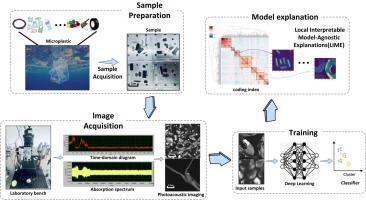当前位置:
X-MOL 学术
›
J. Hazard. Mater.
›
论文详情
Our official English website, www.x-mol.net, welcomes your feedback! (Note: you will need to create a separate account there.)
Advancing microplastic surveillance through photoacoustic imaging and deep learning techniques
Journal of Hazardous Materials ( IF 13.6 ) Pub Date : 2024-04-02 , DOI: 10.1016/j.jhazmat.2024.134188 Mengyuan Huang , Kaitai Han , Wu Liu , Zijun Wang , Xi Liu , Qianjin Guo
Journal of Hazardous Materials ( IF 13.6 ) Pub Date : 2024-04-02 , DOI: 10.1016/j.jhazmat.2024.134188 Mengyuan Huang , Kaitai Han , Wu Liu , Zijun Wang , Xi Liu , Qianjin Guo

|
Microplastic contamination presents a significant global environmental threat, yet scientific understanding of its morphological distribution within ecosystems remains limited. This study introduces a pioneering method for comprehensive microplastic assessment and environmental monitoring, integrating photoacoustic imaging and advanced deep learning techniques. Rigorous curation of diverse microplastic datasets enhances model training, yielding a high-resolution imaging dataset focused on shape-based discrimination. The introduction of the Vector-Quantized Variational Auto Encoder (VQVAE2) deep learning model signifies a substantial advancement, demonstrating exceptional proficiency in image dimensionality reduction and clustering. Furthermore, the utilization of Vector Quantization Microplastic Photoacoustic imaging (VQMPA) with a proxy task before decoding enhances feature extraction, enabling simultaneous microplastic analysis and discrimination. Despite inherent limitations, this study lays a robust foundation for future research, suggesting avenues for enhancing microplastic identification precision through expanded sample sizes and complementary methodologies like spectroscopy. In conclusion, this innovative approach not only advances microplastic monitoring but also provides valuable insights for future environmental investigations, highlighting the potential of photoacoustic imaging and deep learning in bolstering sustainable environmental monitoring efforts.
中文翻译:

通过光声成像和深度学习技术推进微塑料监测
微塑料污染对全球环境构成了重大威胁,但对其在生态系统中形态分布的科学认识仍然有限。这项研究引入了一种综合微塑料评估和环境监测的开创性方法,结合了光声成像和先进的深度学习技术。对各种微塑料数据集的严格管理可以增强模型训练,产生专注于基于形状的辨别的高分辨率成像数据集。矢量量化变分自动编码器 (VQVAE2) 深度学习模型的引入标志着重大进步,展示了在图像降维和聚类方面的卓越能力。此外,在解码前使用矢量量化微塑料光声成像(VQMPA)和代理任务增强了特征提取,从而能够同时进行微塑料分析和区分。尽管存在固有的局限性,这项研究为未来的研究奠定了坚实的基础,提出了通过扩大样本量和光谱学等补充方法来提高微塑料识别精度的途径。总之,这种创新方法不仅推进了微塑料监测,还为未来的环境调查提供了宝贵的见解,凸显了光声成像和深度学习在支持可持续环境监测工作方面的潜力。
更新日期:2024-04-02
中文翻译:

通过光声成像和深度学习技术推进微塑料监测
微塑料污染对全球环境构成了重大威胁,但对其在生态系统中形态分布的科学认识仍然有限。这项研究引入了一种综合微塑料评估和环境监测的开创性方法,结合了光声成像和先进的深度学习技术。对各种微塑料数据集的严格管理可以增强模型训练,产生专注于基于形状的辨别的高分辨率成像数据集。矢量量化变分自动编码器 (VQVAE2) 深度学习模型的引入标志着重大进步,展示了在图像降维和聚类方面的卓越能力。此外,在解码前使用矢量量化微塑料光声成像(VQMPA)和代理任务增强了特征提取,从而能够同时进行微塑料分析和区分。尽管存在固有的局限性,这项研究为未来的研究奠定了坚实的基础,提出了通过扩大样本量和光谱学等补充方法来提高微塑料识别精度的途径。总之,这种创新方法不仅推进了微塑料监测,还为未来的环境调查提供了宝贵的见解,凸显了光声成像和深度学习在支持可持续环境监测工作方面的潜力。



























 京公网安备 11010802027423号
京公网安备 11010802027423号